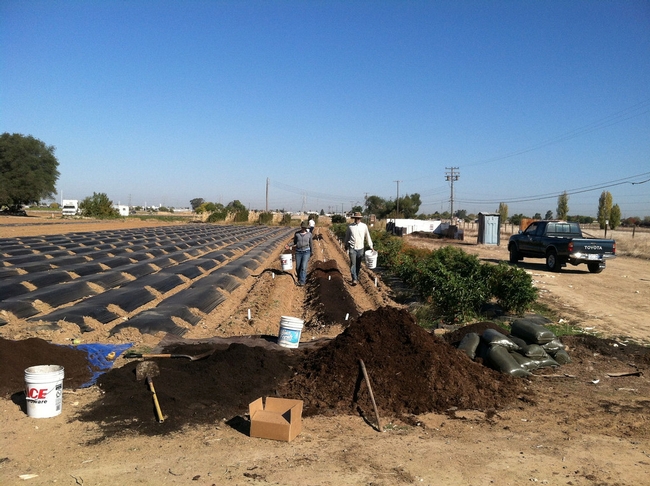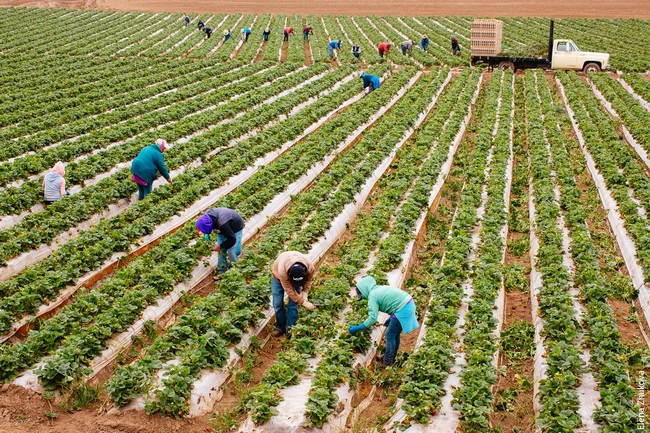
Posts Tagged: methyl bromide
What will California's strawberry industry do without methyl bromide?
2016 is the final year for the soil fumigant to be used in California crop fields.
For many years, California growers relied on methyl bromide to kill a wide range of soil-borne pests, from fungi to insects to weeds, before planting crops. 2016 marks the last year in which the highly effective soil fumigant will be available.
The University of California's peer-reviewed journal California Agriculture examines the impact of the methyl bromide phaseout on strawberries, California's third most valuable crop, behind only almonds and grapes, with annual farmgate sales of $2.5 billion.
First identified as an ozone-depleting compound in 1991, methyl bromide was scheduled for phaseout in the United States by 2005 under the Montreal Protocol, an international agreement to protect the stratospheric ozone layer.
While methyl bromide was used for many crops, California strawberry growers found it irreplaceable, which helped the industry win exemptions that have allowed a significant, though declining, quantity of the chemical to be used through 2016. Despite years of research into alternatives, no equally effective replacement has emerged.

Berry industry grows dramatically
In the first research article, UC Cooperative Extension advisors Laura Tourte and Mark Bolda and Karen Klonsky, emeritus UC Cooperative Extension economics specialist, review economic data on the berry sector — blackberries and raspberries as well as strawberries — in Santa Cruz and Monterey counties. They look ahead to factors, including water, consumer demands, labor, invasive pests, and the full phaseout of methyl bromide, that are likely to shape future growth.
Methyl iodide controversy
In a paper chronicling events leading up to the 2012 withdrawal of methyl iodide, once promoted as a viable methyl bromide substitute, Julie Guthman, UC Santa Cruz professor in the Department of Social Sciences, reports survey findings that point to a variety of reasons why strawberry growers did not move quickly to adopt the chemical after it was approved by state regulators. Concerns about public opposition topped the list, followed by a variety of other factors, including concern about methyl iodide's toxicity, and a lack of strong incentive to switch to the new chemical because of the availability of other fumigants, including methyl bromide.
Managing soilborne pests
Three articles look at new approaches to managing soilborne pests without methyl bromide.
“It now seems likely that no single measure will suffice to meet the challenge of soilborne pathogens,” write Margaret Lloyd, UC Cooperative Extension advisor, and Tom Gordon, UC Davis professor in the Department of Plant Pathology, in this issue's Outlook. “Rather, a multi-faceted approach will be required, one that integrates advances in disease resistance through breeding with closer attention to the factors that influence the survival, activity and spread of pathogen populations in soil.” They make the case for using a suite of strategies to manage soilborne pathogens — including collective action among growers to help limit the spread of pathogens between fields.

A news item on research at the UC ANR Hansen Agricultural Research and Extension Center covers ongoing research on anaerobic soil disinfestation, a chemical-free technique that is being used in a growing number of commercial fields. Project scientist Amanda Hodson and UC Davis professor Edwin Lewis, both in the Department of Entomology and Nematology, review a variety of approaches to managing for soil health — in strawberries and other crops — as a pest suppression strategy.
Other soil fumigants
Fumigants other than methyl bromide, such as chloropicrin, remain widely used in California strawberry production. Rachael Goodhue, UC Davis professor in the Department of Agricultural and Resource Economics at UC Davis, examines how increasingly stringent buffer zone requirements for chloropicrin application have an uneven impact on growers, depending on their proximity to developed land. In another article, a group of UC Cooperative Extension and U.S. Department of Agriculture scientists report on the effectiveness of several fumigants at dosages lower than the maximum label rate.
Food safety and nutrient management on the farm
The issue also includes two research papers focused on general production practices for crops. One report discusses on-farm food safety practices based on a survey of produce growers. The researchers found that practices such as exclusion fencing and vegetation clearing, which may negatively impact wildlife, remain widespread despite a lack of clear evidence that they enhance food safety. Finally, Daniel Geisseler, UC Cooperative Extension specialist in the Department of Land, Air and Water Resources at UC Davis, and Gene Miyao, UC Cooperative Extension advisor, review the use of soil testing to guide the management of soil phosphorus and potassium in California cropping systems.
To read California Agriculture, a peer-reviewed journal of research in agricultural, human and natural resources published by UC Agriculture and Natural Resources, visit http://calag.ucanr.edu. For a free subscription, sign up on the website or write to calag@ucanr.edu.
View this story in Spanish:
¿Qué hará la industria de la fresa sin el bromuro de metilo? http://ucanr.edu/sites/Spanish/noticias/?uid=6887&ds=199. Video on UCANR Spanish YouTube: California Agriculture: el bromuro de metilo en cultivos de fresa https://www.youtube.com/watch?v=5D4FwLqjaLk.
CDPR Seminar: Transition from Methyl Bromide to Alternatives in Strawberry
Pretty short notice here, but UCCE's own Steve Fennimore is giving a seminar on the transition from methyl bromide to alternative pre-plant treatments in strawberry. It will be conveniently webcast, see the information on the flier below.
I'm tuning in for sure, I want to hear from a researcher who actually has spent a lot of time with this stuff in the trenches.

Steve Fennimore Methyl Bromide Alternative Seminar.
Strawberry producers need fumigant alternatives

Methyl bromide use has dropped dramatically over the years and is expected to be completely phased out by 2016, but strawberry farmers still don't have an alternative that works as well. Research is continuing.
"We're going to be using fumigants for a long time," said Steven Fennimore, UC Agriculture and Natural Resources Cooperative Extension specialist based at the USDA ag research station in Salinas. "They're relatively cheap and going all organic exposes you to a lot of pests."
Among the possible solutions shared in the Washington Post are:
- Finding and developing genetic resistance in strawberries to soil-borne diseases
- Anaerobic soil disinfestation, where a soil environment is created that is toxic for plant pathogens
- Steam injection
Fennimore suggests that there is unlikely to be a single tactic to replace methyl bromide.
"People talk about a silver bullet to replace it, and that's a mistake," Fennimore said. "We want to put a lot of treatments together and make it all work."
Can compost be an alternative to methyl bromide?
Writing on Earth Day, I am reminded of one of the world's major successes in environmental protection, the Montreal Protocol. Originally signed in 1987, it works to phase out ozone-depleting substanc
Twenty-seven years later, the realities of enacting the Montreal Protocol are still taking shape, and strawberry growers are, with each harvest year, a step closer to a complete phase out of the fumigant and increased restrictions on alternative chemical fumigants used for disease suppression.
UC research has focused on how to make an economically viable and effective transition away from the soil fumigant. Initial alternatives include replacement chemical fumigants as well as biological fumigants such as anaerobic soil disinfection (such as putting tarps over fields to decrease oxygen), mustard seed meal amendment, or steam disinfestation.
But what if a practice many growers already use could also serve to suppress soil-borne diseases? What if growers could use a substance that provides multiple on-farm benefits?
Many conventional and organic growers alike use compost to boost soil fertility and organic matter. But compost's potential to serve other purposes, including suppressing disease, remain largely unexplored.
Ph.D. student Margaret Lloyd and Tom Gordon, professor in the Department of Plant Pathology at UC Davis, are hoping to close the gap in that knowledge. With a grant from the National Strawberry Sustainability Initiative, a program administered by University of Arkansas and funded by Walmart Foundation, and funding from UC Sustainable Agriculture Research and Education Program, Lloyd's research seeks to understand whether compost can contribute to disease suppression on a commercial scale, and how growers can best incorporate compost into their farm management to see its benefits.
“Compost is part of the production system that has potential as biological control,” says Lloyd. “Historically, we've only focused on it as a source of organic matter or soil nutrients. I'm trying to characterize its role in root health and soil health.”
The study evaluates the root health of strawberry plants, and compares plant yield and disease suppression across a number of research sites and compost types.
“In general, we talk about compost just as compost,” Lloyd said. “But it has drastically different qualities — soil fertility characteristics, physical properties, and microbial profiles. By focusing on different compost sources, the study will help growers better assess their available compost options to m
Alternatives to methyl bromide have been a long time coming. “The research suggests that it won't be one technology replacing another, but a package of tools to help growers manage disease suppression in the soil,” Lloyd said. If some of those tools are already in a grower's tool kit, the transition away from fumigants will be that much smoother.
The research suggests a powerful Earth Day message for me: use what you have, but seek a deeper understanding of just how to use it.
Lloyd's research findings will be completed in 2014, with results available for growers in 2015. Visit the project's website for more information.
UC researchers help growers find alternatives to methyl bromide

A special collection of original research on methyl bromide alternatives is part of the July–September 2013 issue of California Agriculture, UC's peer-reviewed journal of agricultural, natural and human resources (http://californiaagriculture.ucanr.edu). Related articles will appear in the October–December 2013 issue.
Methyl bromide contributes to ozone depletion high in the atmosphere and was banned by developed countries in 2005 under the Montreal Protocol, an international treaty to protect the stratospheric ozone layer. Since then, the treaty has allowed limited use of methyl bromide for certain crops, but many of these exemptions are gone and the rest will end soon.
To develop and evaluate alternatives to methyl bromide, a team of UC and U.S. Department of Agriculture researchers was awarded a $5 million, five-year USDA grant. The project — called the Pacific Area-Wide Pest Management Program for Integrated Methyl Bromide Alternatives (PAW-MBA) — includes production crops such as grapes, strawberries and tree nuts as well as nursery crops such as cut flowers, forest trees and sweet potatoes.
"One goal of the program was to identify methyl bromide alternatives that were immediately useful and economically feasible," says Greg Browne, a USDA plant pathologist at UC Davis who coordinates the PAW-MBA program. "Another was to foster development of nonfumigant strategies for managing soilborne pests."
The team has identified methyl bromide alternatives that are both effective and economical for key California crops. When the best alternative is another fumigant, the researchers found ways to use less and to cut emissions. In addition, the researchers are developing alternatives that go beyond fumigants, including steam sterilization and other nontoxic approaches.
Summaries of projects and links to articles:
TIF film, substrates and nonfumigant soil disinfestation maintain fruit yields
Strawberry growers use methyl bromide primarily to control soilborne diseases. Now, new UC research shows that this crop can be grown without fumigants at small scales. Three nontoxic methods — nonsoil substrates, anaerobic soil disinfestation and steam disinfestation — produced strawberry yields as high as those in conventionally fumigated soil. “Instead of understanding soil, we've just been fumigating it," says Steve Fennimore, a UC Cooperative Extension specialist in Salinas who led this team. "Using physical tools is a different approach." Researchers will next evaluate whether these alternative methods can be scaled up to commercial production fields, and whether they work in different strawberry production areas of California.
Managing the almond and stone fruit replant disease complex with less soil fumigant
Almond and stone fruit growers need methyl bromide alternatives to control nematodes and Prunus replant disease, a soilborne disorder that stunts new orchards and cuts yields. To help these growers, UC and USDA researchers tested alternative fumigants, spot and strip fumigation and nonfumigant methods including rotating orchards with sudangrass and using nematode-resistant rootstock. “Spot treatments provided adequate control of Prunus replant disease and may be very helpful to growers needing to use less fumigant for costs savings or regulatory restrictions,” Browne says. In addition, integrating the various treatments tested may also help control the replant disease with less fumigant use.
Preplant 1,3-D treatments test well for perennial crop nurseries, but challenges remain
California supplies nursery stock to the state's fruit, nut and vineyard industries, as well as more than 60 percent of the rose plants and fruit and nut trees sold nationwide. This perennial nursery stock must be completely nematode-free, and growers use methyl bromide primarily to control these tiny soilborne worms. However, alternative fumigants such as 1,3-dichloropropene (1,3-D) don't work as well in fine soils. "We asked how we could make them work better," says Brad Hanson, a UC Cooperative Extension specialist in the Department of Plant Sciences at UC Davis. The researchers showed that 1,3-D controlled nematodes in fine soil when they tilled it deeper, injected the fumigant deeper and used tarps that kept more of the fumigant in the soil.
Fumigant emission reductions with TIF warrant regulatory changes
Fumigants are regulated partly because they help make smog. Totally impermeable film (TIF) can help keep fumigants in the soil and out of the air. New UC research shows that fumigant emissions can drop 64 percent when fields are tarped with TIF for twice as long as usual (10 days instead of 5). "We're now working on safe use," says Suduan Gao, a USDA soil scientist in Parlier who led the team. "The goal is to keep the fumigant under the tarp long enough that there won't be a surge in emissions when it's cut open." This work gives regulatory agencies a new way to let growers keep using enough fumigant to control pests and diseases while minimizing the smog-forming emissions.
The entire July–September 2013 issue can be downloaded at http://californiaagriculture.ucanr.edu.
California Agriculture is the University of California's peer-reviewed journal of research in agricultural, human and natural resources. For a free subscription, go to: http://californiaagriculture.ucanr.edu, or write to calag@ucanr.edu.
The University of California's Division of Agriculture and Natural Resources is the bridge between local issues and the power of UC research. UC ANR's advisors, specialists and faculty bring practical, science-based answers to Californians. Visit http://ucanr.edu to learn more.
WRITERS/EDITORS: To request a hard copy of the journal, email crllopez@ucanr.edu.


